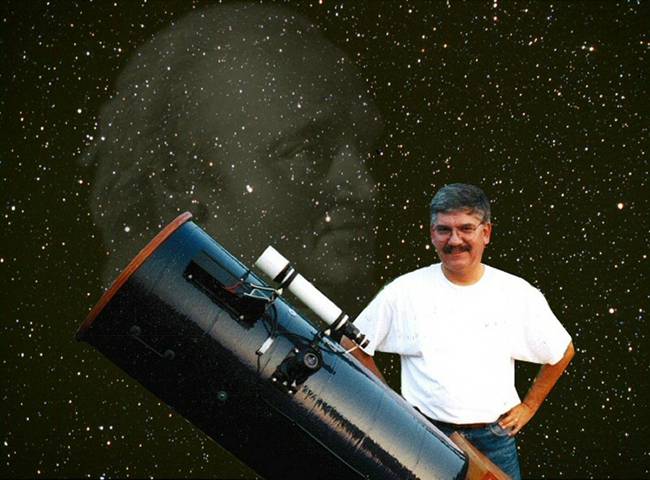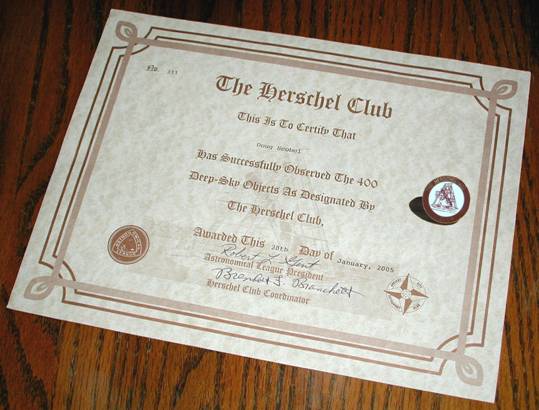


By now most of you know that last year I completed my observation of everything in the so-called Herschel 400 deep sky observing list. But what exactly is the Herschel 400? Did William Herschel himself create the list, or was it his son John? Don’t you need a huge telescope and pristine skies to see most of them? Does it make observing all the Messier objects seem like a walk in the park? To help dispel all the mystery surrounding the Herschel 400, I thought I would try to explain what it is, and describe my own personal experience in pursuing it. Perhaps after reading this you might want to give it a try.
The first thing we have to do is to travel back to the late 1700’s. Amateur astronomer William Herschel (who was actually born Friedrich Wilhelm Herschel in Germany, but moved to England when he was a teenager to study music) was undertaking the world’s first systematic survey of the heavens using his large telescope. By the time he finished, he had compiled observations of 2,477 deep sky objects (including a small number of observations made by his sister Caroline), arguably making him the father of deep sky visual astronomy. Later, his son John took his father’s telescope to South Africa to study the southern sky, logging another 2,153 objects. In 1888, when J. L. E. Dreyer published the New General Catalogue of Nebulae and Clusters of Stars, his compilation of 7840 objects included the 4,630 observations of the Herschels. The catalog, usually referred to as the New General Catalogue, or simply the NGC, was later revised, expanded to over eight thousand objects, and renamed to the Revised New General Catalogue of Nonstellar Astronomical Objects. But objects in the catalog still bear the original NGC designation to this day.
In more modern times, in the late 1970’s, about the only deep sky catalogs from which amateurs could develop an observing program were the well-known Messier catalog of around 110 objects, and the NGC’s more than 8,000 objects. But the NGC was not very convenient, as a large majority of objects are beyond the reach of amateur sized instruments, particularly when used visually. It was then that members of the Ancient City Astronomy Club, of St. Augustine, Florida, created an observing program that they considered a bridge between the Messiers and the NGC. They pulled out 400 objects from the NGC, which would provide a bit of a challenge to experienced observers, yet not be overwhelming. They selected objects that should be within reach of a six inch telescope, when observing under slightly light polluted skies. The founders observed all the objects under skies with a limiting magnitude at the zenith of about 5.5. Surprisingly, some of the objects in the Herschel 400 are also in the Messier catalog, and some are quite large and bright, such as the Double Cluster which is even visible naked eye. But the majority are relatively faint and inconspicuous.
The best place to find the Herschel 400 list is on the Astronomical League’s web site, namely http://www.astroleague.org/al/obsclubs/herschel/hers400.html . There you will find the list, and rules and additional information on the award they offer to those who observe all of the objects. The nice thing about this award is that you do not have to be associated with the Astronomical League to receive it. This was accomplished through a special arrangement with the Ancient City Astronomy Club. (With all other Astronomical League observing clubs, you must either belong to a member society, or be a member at large.) One of the goals of the Astronomical League’s observing clubs is to develop good observation and record keeping techniques on the part of the observer. So, if you intend to apply for the award, then you will have to keep good records of all your observations. At a minimum, for each object you must provide the date and time of the observation, seeing conditions, telescope aperture, magnification used, and a short note describing your observation.
Okay, let’s get to the nitty-gritty. Intentions of the creators of the list aside, what does it really take to observe everything on the list? Today, nearly twenty-five years after the Herschel 400 list was compiled, light pollution has become much more of a problem for deep sky observers. Finding even magnitude 5.5 skies can be something of a challenge for many city dwellers. My guess is that most observers will be severely challenged to observe them all with a six inch telescope. My recommendation is that for most observing sites in southeast Michigan you’ll need a scope with at least eight, or maybe even ten inches of aperture. And of course, you should observe under the darkest skies available to you.
What kind of charts do you need? The ubiquitous Sky Atlas 2000 will let you find a large number of the objects. But in crowded fields such as the Virgo or Coma galaxy clusters, Sky Atlas 2000 often does not provide enough detail to distinguish your target from other objects that may lie nearby. Same goes for objects in fields devoid of enough bright nearby stars for star hopping. Since one of the goals of the program is to develop your observing and record keeping skills, positive identification of your target is essential. So for some of these objects, you’ll need more detailed charts, such as those found in Uranometria 2000 or Millennium Star Atlas. Or, you can print up detailed charts using popular computer star charting programs, such as Guide. Of course, you could use a go-to mount or computer assist, but that would take all the fun and personal satisfaction out of it wouldn’t it? There are also guidebooks for observing the Herschel 400. I’ve not used any, but one example is Observe the Herschel Objects (Astronomical League, 1980). I believe that there are other titles that may be useful.
The obvious question is, how difficult was it? Not as difficult as you might think. I used my 13.1-inch f/4.5 Dobsonian exclusively, so tracking down the objects themselves was pretty easy. The majority of the objects are not very remarkable, but with a few exceptions they have high enough surface brightness to make them relatively easy to find. I did most of my observing at Peach Mountain, Lake Hudson State Recreation Area, at star parties such as the now defunct SMURFS, the Texas Star Party and the Black Forest star Party, and other locations. I did not find sky darkness to be much of a factor except at “The Hill,” which seems to be getting more and more light polluted and higher horizons every year. Light pollution aside, the more difficult problem to overcome was getting enough clear, transparent nights in which to observe. Mid-spring through mid-fall we get decent enough weather here in southeast Michigan, but the rest of the year the clouds are pretty stubborn about letting us see much of the heavens. Plus, during the winter months when it does manage to be clear, it is cold - it often takes a concerted effort to get up the gumption to brave sometimes sub-zero temperatures and pack up all your equipment and drive out to a dark sky site.
I did all my observations the old fashioned way - finder scope and star charts, and telescope drive system by “armstrong.” As I stated earlier, Sky Atlas 2000 was adequate for most objects, but sometimes I had to resort to Uranometria 2000, or even Millennium Star Atlas. The nice thing about Millennium Star Atlas, besides its huge scale, is that it shows the orientation of all galaxies - something Sky Atlas 2000 and the older edition of Uranometria 2000 do not. Knowing how a galaxy is oriented relative to field stars is a big help in crowded galaxy fields to get a positive ID. The new edition of Uranometria 2000, which has been totally redone, does indeed show galaxy orientation, and I suspect it would work fine when Sky Atlas 2000 doesn’t quite cut it. Sky charting software such as Guide also prints galaxies in their correct orientations.
At the 2004 Black Forest Star Party, I finally finished the list. It took several years, but now it was done. Yeah! At first I did not intend to apply for the award, because of the Astronomical League membership and attending monetary requirements I believed I needed to satisfy. It was only after a bit of investigation and running down some blind alleys that I discovered that there are no such requirements for the Herschel 400 award. So late last year I gathered up all my observation records and sent them in to the Herschel club chair. She acknowledged receipt of my application right away, but it took a few months for her to finalize everything and send me the award. But by late March I received a nice certificate (suitable for framing) and lapel pin, and a congratulatory letter. I’m now official!
So in the end what should one make of this observing “feat” of mine? Perhaps a comparison with the list’s namesake will put it into proper perspective. William Herschel had to make his own telescope at a time when one could hardly consider it a hobby. It was state of the art engineering, where much had to be invented. No Dobsonian mountings, no wide-field, well-corrected oculars, no unit power reflex finders, no enhanced mirror coatings (his mirrors were made of solid speculum metal, an alloy of copper and tin, which tarnished easily). In fact, Herschel could not even track objects as we do. His favorite telescope, with a 20 foot focal length, was so large and unwieldy that its alt-azimuth mounting looked more like an enormous hangman’s gallows than a telescope. While he stood at the top of the tube, facing the primary mirror with his back turned to the sky, he had an assistant turn hand wheels, pull ropes, and work levers to keep objects in the eyepiece. He would dictate his observation notes to his wife Caroline who would then write them down. Remember that he had no charts or handbooks to work from - he was exploring what was then the astronomical frontier, meaning nearly every new object he observed, to the tune of nearly 2500 objects, was a new discovery. Compare that to the modern day amateur, with large, stable, trackable telescopes, highly accurate and reflective metal-on-glass mirrors, super-corrected, multi-coated, wide-field eyepieces, detailed star charts, computer databases, and oh, yes, the NGC catalog that Herschel himself started. When I consider all that, I am forced to humbly admit that I have done my observations while standing on the shoulders of a true giant. And I didn’t have to stand on my tippy-toes either!
